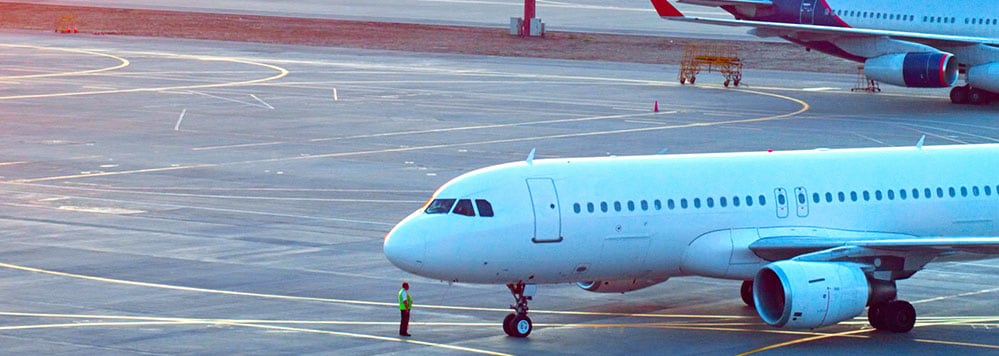COVID-19 has turned the aviation industry upside down. To convince investors of their long-term survival, airlines must use this time to their advantage. By taking the right steps to invest in increased sanitation, optimized processes, improved customer experience, and employee upskilling, airlines can emerge more resilient on the other side of this crisis - and be more competitive when the market returns.
Around the world, the skies are quiet. This pandemic is the worst crisis the airline industry has ever seen. The number of flights scheduled worldwide is down 69.9% for the week of May 4 compared with the year before.1 In February, China saw a more than 80% decline in air traffic compared with the same time last year. The International Air Transport Association (IATA) predicts airline revenue will be down 55% in 2020 — that’s a projected $314 billion drop.
But not all is lost. The airline industry can use the current situation to prepare a long-term strategy and benefits. Airlines should focus on ensuring employee and passenger safety, improving brand loyalty, optimizing processes to improve efficiency and reduce costs, revisiting assets, investing in employee upskilling, exploring opportunities for increased automation, and ways to understand their customers better and give them an extremely differentiated customer experience.
Improve brand loyalty
A large percentage of customers are spending most, if not all, of their time at home. This captive audience could be more receptive to messages that build confidence in traveling. Airlines can use this as a chance to engage customers with opportunities to virtually explore the world or spend loyalty points on long-term shopping vouchers, premium online content, early offers for future travel, and digital content for kids/family. These sorts of goodwill gestures keep the customer close to the airline and ready to come back for travel when restrictions are lifted.
For instance, American Airlines makes about $2.2 billion a year in marketing revenue, which comes primarily from selling frequent flyer points. Airlines generate massive profit from loyalty points, about 20 trillion of which are never used.2 This time, when so many people are not flying, is a good opportunity to engage customers, reduce loyalty point liability, and create add-on revenue. With the current situation, airlines could look at relaxing frequent flyer point rules by extending the qualifying/expiration criteria and providing extreme offers for flight booking and/or immediate redemption.
Optimize processes
Normally, an airline’s operational environment is stressful, with no time for management or staff to identify the weak points in their day-to-day processes. While many airlines are announcing large rounds of redundancies, consideration should also be made for utilizing some excess staff to focus on increasing efficiency and customer satisfaction while reducing costs. Airlines can create task forces to brainstorm and identify areas for improvement.
The vastly reduced number of flights makes it a good time to focus on analyzing past data, situations, and scenarios in depth to identify weak, disruptive, and inefficient process elements and sequences. This could be the agent taking more time serving the passengers in various scenarios, easing booking processes, and looking at the typical aircraft maintenance, repair, and operations (MRO) challenges in the supply chain.
Many of these areas can leverage technology by automating to increase speed and reduce cost, analyzing the available data to generate insights and significantly improve the customer and employee experience.
Fewer flights create time to focus on weak, disruptive and inefficient process elements
This is also a good time to clear off some of the less interesting process backlogs, e.g., updating the process manuals, organizing/structuring the documentation repository, creating user guides, reviewing or updating the business requirements documentation for delayed or upcoming projects, assessing department capabilities, and creating organizational plans for the future when operations get back to normal.
Revisit asset utilization
Beyond the aircraft itself, airlines operate hundreds of physical assets at the airport, warehouse, offices, vendors, kitchen, and data centers to make sure departures happen on time or reduce the impact of delays. Airlines now have time to analyze asset planning, distribution, monitoring, maintenance, and auditing data and assess if it efficiently meets demand and capacity.
Based on the available data, airlines can also work to optimize operations by reducing the number of assets, delays, and disruptions. Partners and vendors may also have more time right now to collaborate with the airline and plan better asset management and tracking as well as a better maintenance framework. This creates an opportunity to define and resolve integration challenges between the airline, airport, authority, and vendor systems to manage assets efficiently in the future.
Cut costs
After 9/11, it took almost 22 months to recover after some airlines filed for bankruptcy and/or merged. ACI World predicts that after this pandemic, the worldwide passenger count may not recover until the end of 2021, considering the deeper situation and the high risk of global recession.3 A U.N. report lists China and India as the only countries that may escape recession.4
Airlines have already been looking at various cost reduction initiatives such as lowering staff expenses by reduction, furlough, reduced working hours, salary reduction, and bonus and incentives reduction. IT expenses can be reduced by canceling or delaying noncritical projects, reducing support and infrastructure cost, moving funds to critical operation costs, putting most of the innovation projects on hold, and delaying IT procurements. Deferred payments or renegotiated contracts are other ways to cut costs.
Now that demand is reduced, airlines may be able to renegotiate orders while also looking for buyers for their old aircraft. Airlines could revisit their lease contracts and MRO strategy while delaying aircraft intake. United Airlines is reportedly following American’s lead by retiring older mainline aircraft and the 50-seater regional jets to consolidate and reduce inefficiencies.5 Singapore Airlines will likely slow down aircraft renewal even more. It’s already moved from aircraft that are, on average, 5.4 years old to the current average age of 7.5 years. This will likely increase even more over the next few years.
Upskill employees
With more staff hours available due to reduced flights, airlines can use this time to upskill employees in processes, tools, technologies, soft skills, languages, and management skills to increase the quality and productivity of their tasks. Depending on the contractual or furlough arrangements that each airline has implemented with its employees, it may well be possible for those colleagues who are unable to contribute to any of the above activities to focus on e-learning from home. With the availability of highly advanced digital training platforms, airlines can quickly implement and execute training plans without much overhead. This could be seen as an alternative to redundancy or furlough — or just an option for those out of work who still want to be employed in aviation in the future. It could enable an engaged and skilled workforce to rejoin the industry more easily once the market recovers.
Ensure safety and security
COVID-19 has highlighted how much monitoring and checking of passengers will be required in the future. The airline industry will need more infrastructure software and processes. A large number of passengers will need to be monitored and checked as airlines try to reduce potential spread at the airport. This will increase the importance of IATA’s One ID initiative, where passengers would use a simple scan of their face, fingerprint, or iris to check in at the airport.
The aviation industry must develop sanitation, hygiene, and health tracking technology as part of its survival strategy
New technologies that can enable automated or quick sanitization are going to be important. For example, Digital Aerolus has designed a disinfection drone that can be used for quick sanitization of aircraft interiors. The drone’s C-band ultraviolet lights are specifically designed to fight COVID-19 spread and have a 99% disinfection rate.6 There’s also a UV-C cleaning machine called the GermFalcon. The machine, which is the size of a food cart and has mechanical wings, is wheeled down the aisle of the plane to disinfect surfaces.
International travelers could also carry a health/immunization card that goes beyond the current yellow fever vaccination record required for some countries, either as a book or through a secured medium like blockchain. Increasing automated passenger identification, health risk/hazard monitoring, and alerting will be key. Whatever the specific solutions, it’s clear that the aviation industry must spearhead the development of sanitation, hygiene, and health tracking technologies as part of its survival strategy.
Optimize and automate
From a technology perspective, there’s an opportunity to upskill tool and technology knowledge. This will reduce dependency on third-party vendors’ knowledge. Automation enhancements can also help reduce the labor intensity of many monitoring tasks and back-office operations. And as with the recommendations above, the IT team can also use the time to look at their data strategy and create a better data analytics and insights platform for improved efficiency once more planes are flying again.
IT projects should also benefit from increased availability of their subject matter experts, who can create business requirements or review documents for upcoming projects. The IT team can also look at the potential reduction in license and infrastructure costs by planning to move systems to the cloud during this time. Another opportunity is to identify the possible migration to open-source databases, which can reduce license costs in the immediate and longer term.
Focus on the future
It is a tougher time than ever for this industry. For many, it might seem pointless to invest in the future when it looks so bleak. Yet this market will come back. Travel is not only the foundation of our economy but also a necessary human requirement — one that will be valued more by businesses and consumers as the world opens up again.
Airlines need a positive and progressive story to persuade investors to support them through these unprecedented times. The best thing an airline can do is be honest about the trouble it’s facing and prepare for a strong future by taking aggressive action now. Airlines should use this downturn to improve every facet of operations and reduce costs wherever possible. They can leverage the plethora of data available in every aspect of its value chain and create insights to help bring down costs and improve the customer experience. COVID-19 has shown us just how quickly the world can change. Being resilient in the face of this breathtakingly fast change will create the kind of airline that your customers, community, and employees need on the other side of this pandemic.
References
- Year-on-year change of weekly flight frequency of global airlines from January 6 to May 4, 2020, by country, May 2020, Statista.com
- How to Earn Airline Frequent-Flier Miles Fast , Eric Rosen, September 19, 2016, National Geographic
- Passenger traffic may only recover end-2021: ACI World , Cirium, April 2, 2020, FlightGlobal
- Coronavirus impact: India and China may escape global recession, says UN, April 1, 2020, Business Standard
- United Could Follow American With Early 757 & 767 Retirement, Joanna Bailey, April 3, 2020, Simple Flying
- World’s First Indoor Disinfection Drone Ready to Fight COVID-19, Alice Ferng, Medgadget.com






